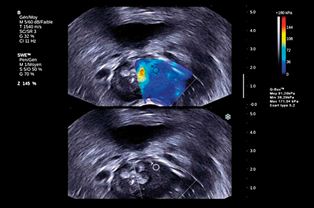Elastography shows promise for detecting cancers without biopsy
18 February 2013
Researchers from the University of Oslo and Beaujon University Hospital in Paris are to start clinical trials of a new method for detecting cancer that measures the elasticity of body tissue.
Elasticity in body tissue is related to the density of blood vessels. Tumours have more blood vessels than healthy tissue and malignant tumours usually have even more blood vessels and a greater blood flow than benign tumours.
"We still don't know a lot about elastography, but the method looks promising. If elastography is the technique we are hoping for, this can become an important examination in the future. This would allow us to use elastography to characterize different types of tumours, such as cancer of the liver", says Anne Cathrine Martinsen, Section Manager of Diagnostic Physics at the Intervention Centre and Associate Professor in the Department of Physics at the University of Oslo.
The examination is simple: the doctor places a vibrator on the location that is to be examined. The vibrator has a pulse of up to 200 oscillations per second and the pressure wave from the vibrator goes through the organ. This allows doctors to study the elasticity of the healthy and diseased parts.
Researchers at the Beaujon University Hospital in Paris are already testing elastography on patients with liver fibrosis, an illness in which the liver has become stiff due to hepatitis or alcohol damage. The Intervention Centre in Oslo is now planning to test the method on Norwegian patients with liver fibrosis to replace a biopsy, which means that patients do not have to have a needle inserted into their liver to take a sample of tissue.
"Elastography-ultrasound is completely different from the current use of ultrasound. Traditional ultrasound sends out a signal that returns as an echo. The problem is that it is impossible to distinguish between malignant and benign tumours with regular ultrasound," said Professor Sverre Holm of the Department of Informatics at the University of Oslo, Norway, to the research magazine Apollon.
Ultrasound creates two types of waves; the most common type is a pressure wave, which penetrates the tissue. The second type, called shear wave, is created by the radiation pressure from the pressure wave and runs horizontally. While pressure waves are mostly affected by fluids, shear waves capture the characteristics of the other 30% of the body that does not consist of water.
Shear waves are created when pressure waves are sent to specific points. From there, the special diagonal energy waves are created. The trick is to use the regular ultrasound waves to measure the diagonal energy pulse.

Ultrasound shear waves can be used to measure
elasticity in soft tissue and distinguish between healthy tissue and
tumours, as shown by the colouring.
"We must reconstruct what happens. We must discard all information from the pressure waves and only retain the information from the shear waves," said Professor Holm.
The pressure wave has a speed of 1,500 metres a second, while the shear wave has a speed of one to ten metres a second. "A regular ultrasound scanner takes a hundred images a second. The speed must be increased to a thousand images a second in order to capture shear waves. To manage this speed, we must sacrifice some of the image quality," said Postdoctoral Fellow Peter Näsholm of the Department of Informatics at Oslo University.
If the frequency changes, the speed of the waves will change. It turns out that the more dangerous a tumour is, the the higher the speed of the waves is. A large calculation capacity is required to interpret these waves and the mathematics is complicated.
"If elastography is to replace breast cancer screening, it must be able to see smaller tumours and to see the tumours better than it does currently. In mammography, it is difficult to detect small tumours. There is hope that elastography can also be used to see small tumours, but there is still quite a way to go", notes radiologist Per Kristian Hol of the Intervention Centre in Oslo.